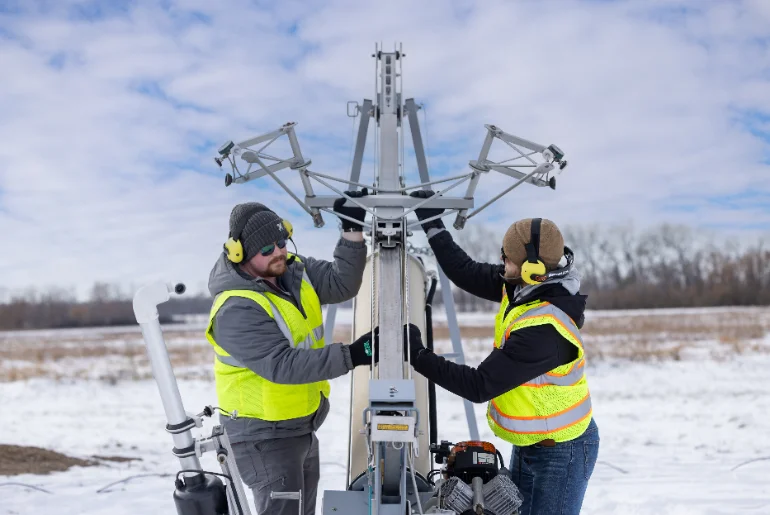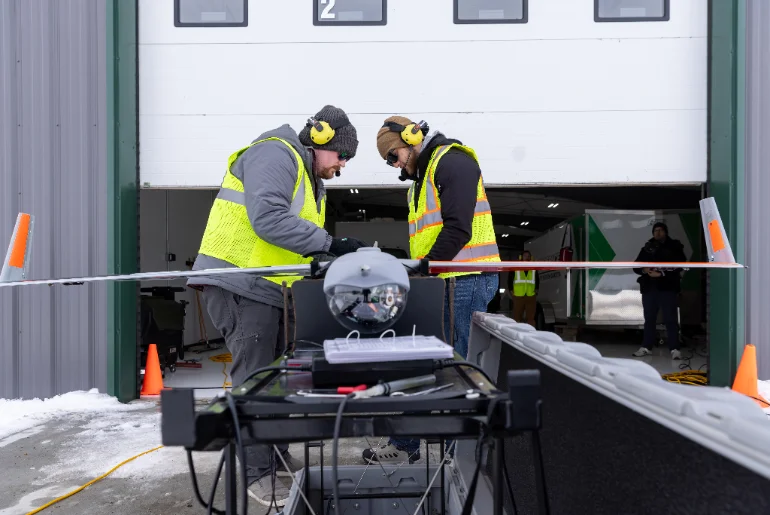
Aerospace Engineer: Salary, Job Description and Outlook
Explore the world of aerospace engineering and discover the salary potential and career opportunities in this exciting field.
Request Information
From average earnings to factors affecting pay, this article guides you through what to expect as an aerospace engineer. Whether you're considering a career in aerospace or seeking to advance, we provide the insights you need for a successful journey in aerospace engineering.
Much like how flying unlocks new horizons, aerospace engineering unlocks the boundless potential of technology, pushing the boundaries of what's possible with each new advancement.
This article sheds light on what aerospace engineers earn, the factors influencing their salaries and the promising career outlook in this innovative field. Join us as we delve into the financial and professional rewards of pursuing a future in aerospace engineering, from the average salary to the exciting opportunities that lie ahead.
What Is an Aerospace Engineer?
Aerospace engineers are the architects of the skies, specializing in the intricate design, development and maintenance of a wide array of aerospace vehicles and systems. Their expertise extends across various technologies, including aircraft, spacecraft, satellites and more.
Armed with a profound grasp of physics, mathematics and engineering principles, these experts meticulously shape and fine-tune aerospace technologies, ensuring peak performance coupled with paramount safety.
Aerospace Engineer Salary
Aerospace engineers command competitive salaries reflective of their specialized skills and contributions to the field. According to data from the Bureau of Labor Statistics (BLS), the median annual wage for aerospace engineers stands at $134,830. This figure represents the midpoint, as the lowest 10% of earners in this profession take home less than $78,170 annually, while the highest 10% earn over $176,280 per year.
Within the field of aerospace engineering, professionals occupy various roles, each with its unique responsibilities and salary ranges. Let's go through some of these roles:
Thermodynamics Engineer
Thermodynamics engineers specialize in the study of heat and energy transfer within aerospace systems. They analyze and optimize the efficiency of propulsion systems and thermal management solutions. On average, thermodynamics engineers earn an annual pay of $115,864, with salaries ranging from $38,000 to $191,500 per year.
Aeronautical Engineer
Aeronautical engineers focus on designing, developing and testing aircraft and related systems. They work to improve flight performance, aerodynamics and structural integrity. The average annual pay for aeronautical engineers is $130,258, with salaries spanning from $49,000 to $205,000 per year.

Aircraft Design Engineer
Aircraft design engineers are tasked with creating and refining the overall design and layout of aircraft, ensuring aerodynamic efficiency, structural integrity and safety. These professionals earn an average annual pay of $152,999, with salaries ranging from $120,000 to $176,000 per year.
Airframe Design Engineer
Airframe design engineers specialize in designing and optimizing the structural framework of aircraft, including wings, fuselage and empennage. They ensure that airframes meet performance, safety and regulatory requirements. On average, airframe design engineers earn $120,241 annually, with salaries ranging from $71,000 to $178,500 per year.
Spacecraft Systems Engineer
Spacecraft systems engineers are responsible for the design, integration and testing of spacecraft subsystems, such as propulsion, power and communication systems. They ensure the reliability and functionality of spacecraft in the harsh environment of space. The average annual pay for spacecraft systems engineers is $124,441, with a salary range of $84,500 to $174,500 per year.
Propulsion Systems Engineer
Propulsion systems engineers specialize in the design, analysis and optimization of propulsion systems for aircraft and spacecraft. They develop engines and propulsion systems that provide thrust for flight and maneuverability. Propulsion systems engineers earn an average annual pay of $122,519, with salaries ranging from $62,500 to $184,000 per year.
Flight Test Engineer
Flight test engineers are responsible for planning, executing and analyzing flight tests to evaluate the performance and safety of aerospace vehicles. They assess aircraft and spacecraft under various operating conditions to identify and address potential issues. On average, flight test engineers earn $134,885 annually, with salaries ranging between $43,500 and $204,000 per year.
Factors That Influence Salary
As mentioned, the salary of aerospace engineers varies widely, reflecting the diverse roles encompassed within the field, each offering different compensation levels. In addition to the roles, several other factors, including education, experience and geographic location, play significant roles in shaping the earning potential of aerospace engineers.
Education
A strong educational foundation is crucial for aspiring aerospace engineers. Most professionals in the field hold at least a bachelor's in Aerospace Engineering, Mechanical Engineering or a related degree. These programs typically cover fundamental principles in aerodynamics, aircraft design, propulsion systems and materials science.
However, advanced degrees such as a master's in Space Studies or an Aerospace Sciences Ph.D. can provide deeper specialization and open doors to leadership roles or research positions. Continuing education through certifications and professional development courses also allows engineers to stay current with industry trends and technologies, potentially leading to higher-paying opportunities.
Experience
In most careers, including aerospace engineering, the more experience a person accumulates, the higher their earning potential. This is because experienced professionals typically possess a deeper understanding of their field, can take on more responsibilities and often contribute to more complex projects, all of which are highly valued by employers.

Therefore, as aerospace engineers gain practical experience through internships, co-op programs or entry-level positions, they develop valuable skills and knowledge, such as advanced problem-solving abilities, proficiency in industry-standard software and tools as well as the ability to effectively collaborate with multidisciplinary teams.
Location
Certain regions with established aerospace industries offer abundant job prospects and competitive salaries to attract top talent. The top-paying states for aerospace engineers include:
| State | Annual mean wage |
|---|---|
| District of Columbia | $152,400 |
| Maryland | $152,180 |
| Washington | $150,390 |
| Colorado | $1343,630 |
| California | $143,050 |
Factors such as cost of living, demand for aerospace talent and industry concentration lead to such salary disparities across different locations.
Career Outlook for Aerospace Engineers
According to BLS, the job market outlook for aerospace engineers is promising, with a projected 6% growth from 2024 to 2034, outpacing the average for all occupations. This growth translates to approximately 3,800 annual openings for these professionals, driven by various factors.
It is noteworthy that initiatives to redesign aircraft with the aim of reducing noise pollution and improving fuel efficiency are expected to create a demand for aerospace engineers. Additionally, technological advancements have substantially reduced the cost of satellite launches, making space more accessible than ever before. This accessibility, combined with the increasing commercial viability of small satellites, is set to drive demand for aerospace engineers in the space sector.
Moreover, the BLS reports that the sustained interest in drones for applications such as forest fire detection has also contributed to the growth of employment opportunities for aerospace engineers. And lastly, the need to replace workers who are transferring to other occupations or retiring from the workforce is likely to create several job opportunities.
Advancing in Aerospace Engineering
Advancing in the field of aerospace engineering involves a combination of continued education, skill development and strategic career moves. Here are key steps to progress in this dynamic field:
- Continuous learning: Stay updated with the latest advancements in aerospace technology. Pursuing higher education, such as a master's degree or Ph.D., can provide deeper expertise and open doors to higher-level positions.
- Gaining practical experience: Hands-on experience is crucial. Working on diverse projects and accepting challenging assignments helps build a robust skill set.
- Specialization: Specializing in high-demand areas can set you apart and lead to more advanced roles.
- Professional networking: Building a strong professional network through industry conferences, professional associations and online forums can lead to career advancement opportunities.
- Certifications and skills development: Obtaining certifications from recognized aerospace bodies and keeping skills up-to-date with current industry software and tools can enhance your career prospects.
- Leadership and management skills: Developing strong leadership and project management skills is important for moving into higher roles, such as project manager or department head.
- Performance excellence: Consistently delivering high-quality work and contributing innovative solutions to complex engineering problems can lead to recognition and career advancement.
By focusing on these areas, aerospace engineers can strategically navigate their career paths toward advanced roles, ensuring both professional growth and increased earning potential.
Conclusion
All in all, aerospace engineering offers a unique blend of challenge, reward and excitement. With its diverse range of roles and excellent salaries, coupled with a promising job outlook, this field promises both personal fulfillment and professional growth.
Whether you're considering entering the field through our Aerospace Engineering bachelor's degree or advancing your career with our Aerospace Sciences Ph.D. program, your potential is limitless. Embark on your aerospace engineering journey with us and reach new heights in your career.
FAQs
According to the U.S. Bureau of Labor Statistics, aerospace engineers typically work full-time and some may work more than 40 hours per week. This indicates that the nature of their work can often extend beyond standard working hours.
Benefits for aerospace engineers may include health insurance, retirement plans, paid time off and opportunities for professional development and advancement within the industry. However, the availability of these benefits depends on the employer.
Aerospace engineering can be challenging due to the complex nature of designing and developing aircraft and spacecraft, requiring strong problem-solving skills, attention to detail and continuous learning to stay abreast of advancements in the field.